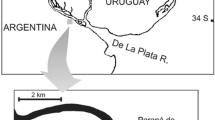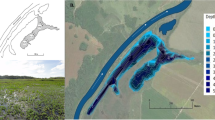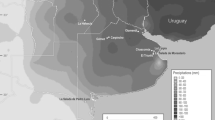Abstract
This 10-year field data study explores the relevance of water level fluctuations in driving the shift from a free-floating plant (FFP) to a phytoplankton dominated state in a shallow floodplain lake from the Lower Paraná River. The multi-year natural flood pulse pattern in the Lower Paraná River drove the ecosystem regime from a FFP-dominant state during very high waters (1998–1999) to absolute phytoplankton prevalence with blooms of nitrogen fixing Cyanobacteria during extreme low waters (2008–2009). Satellite images support the observed changes over the decade and show the decrease of the surface lake area covered by FFP as well as the modification of the spectral firm in open waters, which documents the significant increases in phytoplankton chlorophyll a concentrations. We discuss the possibility that, despite a slow eutrophication in these highly vegetated systems, water level changes and not nutrients account for the shift from a floating macrophyte community to phytoplankton dominance. Cyclic shifts may occur in response to the seasonal floodpulse, but more strongly, as indicated by our results, in association to the extreme drought and flood events related to the El Niño Southern Oscillation, which is linked to discharge anomalies in the Paraná River.





Similar content being viewed by others
References
Adrian R, O’Reilly CM, Zagarese H, Baines SB, Hessen DO, Keller W, Livingstone DM, Sommaruga R, Straile D, Van Donk E, Weyhenmeyer GA, Winder M (2009) Lakes as sentinels of climate change. Limnol Oceanogr 54:2283–2297
Agawin NSR, Rabouille S, Veldhui MJW, Servatius L, Hol S, van Overzee HMJ, Huisman J (2007) Competition and facilitation between unicellular nitrogen-fixing cyanobacteria and non-nitrogen-fixing phytoplankton species. Limnol Oceanogr 52:2233–2248
APHA (American Public Health Association) (2005) Standard Methods for the examination of waters and wastewater, 21st edn. APHA, Washington, DC
Atlas Ambiental de Buenos Aires (2008) http://atlasdebuenosaires.gov.ar. Accessed 3 March 2010
Auge M (2004) Vulnerabilidad de acuíferos. Rev Latino-Americana de Hidrogeol 4:85–103
Beisner BE, Haydon DT, Cuddington K (2003) Alternative stable states in ecology. Front Ecol Environ 1:376–382
Beklioglu M, Altinayar G, Tan CO (2007) Water level control over submerged macrophyte development in five shallow lakes of Mediterranean Turkey. Arch Hydrobiol 166:535–556
Bicudo DD, Fonseca BM, Bini LM, Crossetti LO, CEdM Bicudo, Araújo-Jesus T (2007) Undesirable side-effects of water hyacinth control in a shallow tropical reservoir. Freshwater Biol 52:1120–1133
Blindow I, Andersson G, Hargeby A, Johansson S (1993) Long-term pattern of alternative stable states in two shallow eutrophic lakes. Freshwater Biol 30:159–167
Camilloni A, Barros VR (2000) The Paraná River response to El Niño 1982–83 and 1997–98 events. J Hydrometeorology 1:412–429
Camilloni IA, Barros VR (2003) Extreme discharge events in the Paraná River and their climate forcing. J Hydrol 278:94–106
Cardoso AO, Silva Dias PL (2006) The relationship between ENSO and Paraná River Flow. Adv Geosci 6:189–193
Chichizola SE (1993) Las comunidades vegetales de la Reserva Natural Estricta de Otamendi y sus relaciones con el ambiente. Parodiana 8:227–263
Coops H, Beklioglu M, Crisman TL (2003) The role of water-level fluctuations in shallow lake ecosystems–workshop conclusions. Hydrobiologia 506–509:23–27
de Tezanos Pinto P, Litchman E (2010) Eco-physiological responses of nitrogen-fixing cyanobacteria to light. Hydrobiologia 639:63–68
de Tezanos Pinto P, Allende L, O’Farrell I (2007) Influence of free floating plants on the structure of a natural phytoplankton assemblage: an experimental approach. J Plankton Res 29:47–57
Engle DL, Melack JM (1993) Consequences of riverine floodplain for seston and the periphyton of floating meadows in an Amazon floodplain lake. Limnol Oceanogr 38:1500–1520
Garcia de Emiliani MO (1997) Effects of water level fluctuation in a river-floodplain lake system (Paraná River, Argentina). Hydrobiologia 357:1–15
Hair JF (1990) Multivariate data analysis with readings. Macmillan, New York
Haller WT, Sutton DL, Barlowe WC (1974) Effects of salinity on growth of several aquatic macrophytes. Ecology 55:891–894
Hamilton SK, Lewis WM (1987) Causes of seasonality in the chemistry of a lake on the Orinoco River floodplain, Venezuela. Limnol Oceanogr 32:1277–1290
Hamilton DP, Mitchell SF (1988) Effects of wind on nitrogen, phosphorus and chlorophyll a in a shallow New Zealand lake. Verh Internat Verein Theor Angew Limnol 23:624–628
Hargeby A, Blindow I, Andersson G (2007) Long-term patterns of shifts between clear and turbid states in Lake Krankesjön and Lake Tåkern. Ecosystems 10:28–35
Huszar HLV (2000) A comunidade fitoplanctônica e sua relação com o pulso hidrologico e o rejeito de bauxita. In: Bozelli R, Esteves FA, Roland F (eds) Lago Batata: Impacto e reuperação de um ecossitema Amazônico, Rio de Janeiro. Inst Biologia-UFRJ/Soc Bras Limnologia, Brazil, pp 91–104
INTA (Instituto Nacional de Tecnología Agropecuaria) (1990) Atlas del suelo de la República Argentina. Escala 1:500000 y 1:1000000. Secretaría de Agricultura, Ganadería y Pesca. Proyecto PNUA ARG. 85/109. INTA. Centro de Investigaciones de Recursos Naturales
IPCC (Intergovernmental Panel on Climate Change) (2007) Fourth Assessment Report. http://www.ipcc.ch/. Accessed 3 March 2010
Izaguirre I, Sinistro R, O’ Farrell I, Unrein F, Tell G (2001) Algal assemblages in anoxic relictual oxbow lakes from the Lower Paraná floodplain (Argentina). Nova Hedwigia 123:95–106
Izaguirre I, O’Farrell I, Unrein F, Sinistro R, dos Santos Afonso M, Tell G (2004) Algal assemblages across a wetland, from a shallow lake to relictual oxbow lakes (Lower Paraná River, South America). Hydrobiologia 511:25–36
Izaguirre I, Pizarro H, de Tezanos Pinto P, Rodríguez P, O’Farrell I, Unrein F, Gasol J (2010) Macrophyte influence on the structure and productivity of photosynthetic picoplankton in wetlands. J Plankton Res 32:221–238
Jentsch A, Kreyling J, Beierkuhnlein C (2007) A new generation of climate-change experiments: events, not trends. Front Ecol Environ 5:365–374
Jeppesen E, Jensen JP, Søndergaard M, Lauridsen T (2005) Response of fish and plankton to nutrient loading reduction in 8 shallow Danish lakes with special emphasis on seasonal dynamics. Freshwater Biol 50:1616–1627
Jeppesen E, Søndergaard M, Meerhoff M, Lauridsen TL, Jensen JP (2007a) Shallow lake restoration by nutrient loading reduction—some recent findings and challenges ahead. Hydrobiologia 584:239–252
Jeppesen E, Søndergaard M, Pedersen AR, Jürgens K, Strzelczak A, Lauridsen TL, Johansson LS (2007b) Salinity induced regime shift in shallow brackish lagoons. Ecosystems 10:47–57
Junk WJ (1986) Aquatic plants of the Amazon system. In: Davies BR, Walker KF (eds) The ecology of river systems. WJ Junk Publishers, Dordrecht, pp 319–338
Junk WJ, Piedade MTF (1997) Plant life in the floodplain with special reference to herbaceous plants. In: Junk WJ (ed) The Central Amazon floodplain: ecology of a pulsing system. Springer, Berlin, pp 147–185
Junk WJ, Welcomme RL (1990) Floodplains. In: Pattern BC (ed) Wetlands and shallow continental water bodies. SPB Academic Publishing, The Hague, pp 491–524
Junk WJ, Bayley PB, Sparks RE (1989) The flood pulse concept in River-floodplain systems. In: Dodge DP (ed) Proceeding of the International Large River Symposium, Can Spec Publ Fish Aquat Sci 106, pp 110–127
Kandus P, Adamoli JM (1993) Freshwater marsh vegetation response to flooding patterns in the lower delta of the Paraná River. Wetl Ecol Manag 2:213–222
Koroleff F (1983) Simultaneous oxidation of nitrogen and phosphorus compounds by persulfate. In: Grosshoff K, Eberhodt M, Kremling K (eds) Methods of seawater analysis. Verlag Chemie, Wainheimer, pp 168–169
Kronberg L (1999) Content of humic substances in freshwater. In: Eloranta JKP (ed) Limnology of Humic Waters. Backhuys Publishers, Leiden, pp 9–10
Lorenzen CJ (1967) Determination of chlorophyll and pheopigments: spectrophotometric equations. Limnol Oceanogr 12:343–346
Loverde-Oliveira SM, Huszar VLM, Mazzeo N, Scheffer M (2009) Hydrology-driven regime shifts in a shallow tropical lake. Ecosystems 12:807–819
Malvárez AI (1999) Tópicos sobre humedales subtropicales y templados de Sudamérica. ORCYT, Montevideo
Menken K, Brezonik PL, Bauer ME (2006) Influence of chlorophyll and colored dissolved organic matter (CDOM) on lake reflectance spectra: implications for measuring lake properties by remote sensing. Lake Reserv Manag 22:179–190
Moss B, Madgewick J, Phillips G (1996) A guide to the restoration of nutrient enriched shallow lakes, WW Hawes, UK
Neiff JJ (1990) Ideas para la interpretación ecológica del Paraná. Interciencia 15:424–441
Netten JJC, Arts GHP, Gylstra R, van Nes EH, Scheffer M, Roijackers RMM (2005) Effect of temperature and nutrients on the competition between free-floating Salvinia natans and submerged Elodea nuttallii in mesocosms. Fundam Appl Limnol Arch Hydrobiol
Nusch EA (1980) Comparison of different methods for chlorophyll and phaeopigments determination. Arch Hydrobiol Beih Ergebn Limnol 14:14–36
O’Farrell I, Sinistro R, Izaguirre I, Unrein F (2003) Do steady state algal assemblages occur in the shallow lentic environments from wetlands? Hydrobiologia 502:197–209
O’Farrell I, de Tezanos Pinto P, Rodríguez PL, Chaparro G, Pizarro HN (2009) Experimental evidence of the dynamic effect of free-floating plants on phytoplankton ecology. Freshw Biol 54:363–375
Paerl HW, Huisman J (2009) Climate change: a catalyst for global expansion of harmful cyanobacteria blooms. Environ Microbiol Rep 1:27–37
Paillisson JM, Marion L (2006) Can small water level fluctuations affect the biomass of Nymphaea alba in large lakes? Aquatic Bot 8:259–266
Peel MC, Finlayson BL, McMahon TA (2007) Updated world map of the Köppen-Geiger climate classification. Hydrol Earth Syst Sci 11:1633–1644
Price GD, Badger MR, Woodger FJ, Long BM (2008) Advances in understanding the cyanobacterial CO2-concentrating-mechanism (CCM): functional components, Ci transporters, diversity, genetic regulation and prospects for engineering into plants. J Exp Bot 59:1441–1461
Rai H, Hill G (1984) Primary production in the Amazonian aquatic ecosystem. In: Sioli H (ed) The Amazon Limnology and landscape of a mighty tropical river and its basin. Junk, The Hague, pp 311–335
Reynolds CS (2006) Ecology of Phytoplankton. Cambridge University Press, Cambridge, p 535
Rodríguez P, Pizarro H (2007) Phytoplankton productivity in a highly colored shallow lake of a South American floodplain. Wetlands 27:1153–1160
Scheffer M (1998) Ecology of shallow lakes. Chapman & Hall, London
Scheffer M, Jeppesen E (2007) Regime shifts in shallow lakes. Ecosystems 10:1–3
Scheffer M, van Nes EH (2007) Shallow lakes theory revisited: various alternative regimes driven by climate, nutrients, depth and size. Hydrobiologia 584:455–466
Scheffer M, Hosper SH, Meijer ML, Moss B, Jeppesen E (1993) Alternative equilibria in shallow lakes. Trends in Ecol Evolut 8:275–279
Scheffer M, Szabó S, Gragnani A, van Ness EH, Rinaldi S, Kautsky N, Norberg J, Roijackers RMM, Franken RJM (2003) Floating plant dominance as a stable state. Proc Natl Acad Sci 100:4040–4045
Schmidt GW (1973) Primary production in the three types of Amazonian waters. 3. Primary productivity of phytoplankton in a tropical floodplain lake of Central Amazonia, Lago do Castanho, Amazonas, Brazil. Amazoniana 4:379–404
Schröder A, Persson L, De Roos AM (2005) Direct experimental evidence for alternative stable states: a review. Oikos 110:3–19
Sculthorpe CD (1967) The biology of aquatic vascular plants. Edward Arnold Publishers, London
Silva Busso A, Santa Cruz J (2005) Distribución de elementos traza en las aguas subterráneas del Partido de Escobar, Buenos Aires, Argentina. Ecología Aust 15:31–47
Sinistro R, Izaguirre I, Asikian V (2006) Experimental study on the microbial plankton community in a South American wetland (Lower Paraná River Basin) and the effect of the light deficiency due to the floating macrophytes. J Plankton Res 28:753–768
Smith AJ (1983) Modes of cyanobacterial carbon metabolism. Ann Microbiol 134B:93–113
Stumpf RP (1992) Remote sensing of water clarity and suspended sediments in coastal waters. In: Proceedings of the first thematic Conference on remote sensing for Marine and coastal Environments, New Orleans, SPIE 1930: pp 293–305
Sváb E, Tyler AN, Preston T, Présing M, Balogh KV (2005) Characterizing the spectral reflectance of algae in lake waters with high suspended sediment concentrations. IJRS 26:919–928
Ter Braak CJF (1994) Canonical community ordination. Part I. Basic theory and linear methods. Ecoscience 1:127–140
Thomaz SM, Lansac-Tôha FA, Roberto MC, Esteves FA Lima AF (1992) Seasonal variation of some limnological factors of Lagoa do Guaraná, a várzea lake of the high Paraná River, State of Mato Grosso do Sul, Brazil. Rev Biol Trop 25:269–276
Train S, Rodrigues LC (1998) Temporal fluctuations of the phytoplankton community of the Baía River, in the Upper Paraná River floodplain, Mato Grosso do Sul, Brazil. Hydrobiolgia 361:125–134
Unrein F, O’Farrell I, Izaguirre I, Sinistro R, dos Santos Afonso M, Tell G (2010) Phytoplankton response to pH rise in a N-limited floodplain lake: relevance of N2-fixing heterocystous cyanobacteria. Aquat Sci 72:179–190
Utermöhl M (1958) Zur Vervollkommung der quantitativen Phytoplankton Methodik MIH. Verh Internat Verein Theor Angew Limnol 9:1–38
Van Geest GJ, Coops H, Scheffer M, van Nes EH (2007) Long transient near the ghost of a stable state in eutrophic shallow lakes with fluctuating water levels. Ecosystems 10:36–46
van Nes EH, Scheffer M (2007) Slow recovery from perturbations as a generic indicator of a nearby catastrophic shift. Am Nat 169:738–747
van Nes EH, Rip WJ, Scheffer M (2007) A theory for cyclic shifts between alternative states in shallow lakes. Ecosystems 10:17–27
Venrick EL (1978) How many cells to count? In: Sournia A (ed) Phytoplankton Manual. UNESCO Press, Paris, pp 167–180
Wallsten M, Forsgren PO (1989) The effects of increased water level on aquatic macrophytes. J Aquat Plant Manag 27:32–37
Wantzen KM, Junk WJ, Rothhaupt KO (2008) An extension of the floodpulse concept (FPC) for lakes. Hydrobiologia 1:151–170
Williamson CE, Saros JE, Vincent WF, Smol JP (2009) Lakes and reservoirs as sentinels, integrators and regulators of climate change. Limnol Ocenogr 54:2273–2282
Zar JH (1996) Biostatistical analysis. Prentice Hall, Upper Saddle River
Acknowledgments
We wish to thank the staff of the Reserva de Otamendi for their field assistance, Dr. Patricia Kandus for helping with the satellite images analysis, Dr. Inés Camilloni for her assistance in the interpretation of meteorological and discharge anomalies, Servicio Meteorológico Nacional for providing the meteorological data, Subsecretaría de Puertos y Vías Navegables for the hydrological data and CONAE for the satellite images. We wish to thank the corrections and suggestions made by anonymous reviewers and the editor. The work presented here was financially supported by the CONICET (PIP 5355,167, PEI 6382), UBA (UBACYT ×195, X815) and ANCYPT (PICT 4502, 12332, 536).
Author information
Authors and Affiliations
Corresponding author
Rights and permissions
About this article
Cite this article
O’Farrell, I., Izaguirre, I., Chaparro, G. et al. Water level as the main driver of the alternation between a free-floating plant and a phytoplankton dominated state: a long-term study in a floodplain lake. Aquat Sci 73, 275–287 (2011). https://doi.org/10.1007/s00027-010-0175-2
Received:
Accepted:
Published:
Issue Date:
DOI: https://doi.org/10.1007/s00027-010-0175-2




